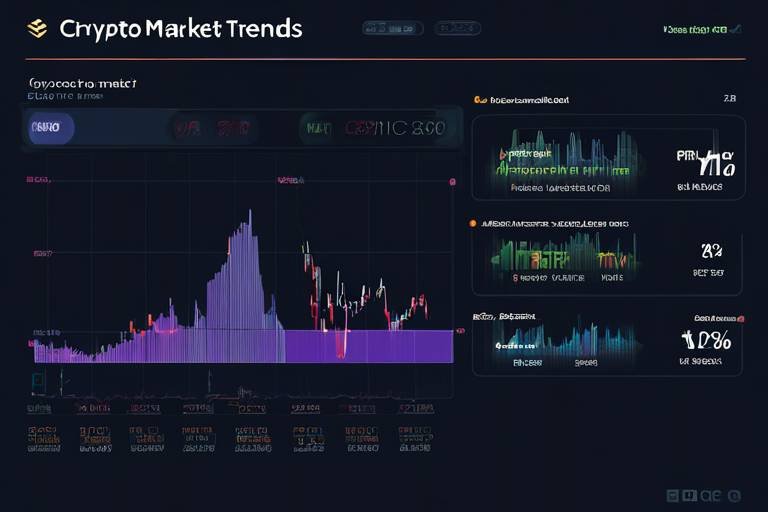Best Practices for Setting Trading Goals
Setting trading goals is akin to charting a course on a vast ocean; without a clear destination, one can easily drift into uncertainty. In the world of trading, where volatility reigns and emotions can run high, establishing well-defined goals is not just beneficial—it's essential. These goals serve as your compass, guiding you through the tumultuous waters of the financial markets. They provide direction, motivation, and a framework for evaluating your performance over time. By focusing on specific objectives, traders can enhance their performance, maintain focus, and ultimately achieve success.
Imagine embarking on a journey without a map. You might enjoy the scenery, but you could end up lost or, worse, in a place you never intended to be. Similarly, in trading, having clear goals helps you navigate through various strategies, market conditions, and emotional challenges. It’s not just about making money; it’s about understanding what you want to accomplish and how to get there. So, let’s dive deeper into the best practices for setting effective trading goals.
Establishing clear trading goals is crucial for success. They act as your guiding principles, providing a sense of purpose and direction. When you have specific goals in place, you're more likely to stay focused and committed, even when the market throws curveballs your way. Think of your trading goals as a personal mission statement. They help you evaluate your performance and adjust your strategies based on what works and what doesn’t.
Moreover, having well-defined goals can significantly boost your motivation. When you know what you're working towards, it becomes easier to put in the necessary effort and time. For instance, if your goal is to achieve a specific percentage return on your investments within a set timeframe, this target can drive your daily trading decisions. Ultimately, trading goals help you maintain a disciplined approach, which is vital for long-term success.
The SMART criteria—Specific, Measurable, Achievable, Relevant, and Time-bound—offer a structured approach to goal-setting that can be incredibly beneficial for traders. Let's break it down:
- Specific: Your goals should be clear and precise. Instead of saying, "I want to make money," specify how much you want to earn and by when.
- Measurable: Ensure that your goals can be quantified. This allows you to track your progress and make necessary adjustments.
- Achievable: Set realistic goals that challenge you but are still attainable given your current skills and market conditions.
- Relevant: Your goals should align with your overall trading strategy and personal financial objectives.
- Time-bound: Establish deadlines for your goals to create a sense of urgency and accountability.
Applying the SMART principles to your trading goals can significantly enhance your focus and effectiveness. It transforms vague aspirations into actionable plans, making it easier to stay on track and measure your success.
Specificity in goal-setting helps clarify what a trader wants to achieve. For instance, instead of setting a broad goal like "I want to improve my trading," a specific goal would be "I want to increase my monthly trading profits by 15% over the next three months." This level of detail not only provides clarity but also makes it easier to devise a strategy to reach that goal.
Here are a few practical examples of specific trading goals:
- Achieve a 20% return on investment by the end of Q2.
- Complete a trading course and implement one new strategy each month.
- Reduce trading losses by 10% over the next six months.
Vague goals can lead to confusion and lack of focus. When traders set non-specific objectives, they often find themselves wandering aimlessly, unsure of what steps to take next. For example, saying "I want to be a better trader" provides no clear direction. Instead, aim for clarity and specificity to ensure that your goals are actionable and measurable.
Measurable goals allow traders to track their progress effectively. Whether it's the number of trades executed in a month, the percentage of profitable trades, or the overall return on investment, quantifiable targets are essential for assessing performance. By setting measurable goals, you can easily identify what’s working and where adjustments are needed.
Realistic goals ensure that traders remain motivated and engaged. It’s easy to get carried away with ambition, but setting unattainable goals can lead to frustration and burnout. Balance ambition with attainability by considering your current skills, market conditions, and available resources.
Understanding market conditions is vital for setting achievable goals. Traders should regularly analyze market trends, economic indicators, and other relevant factors that could impact their trading strategies. By staying informed, you can set realistic goals that reflect the current market landscape.
Flexibility in goal-setting is essential. Markets are dynamic, and what may have been a realistic goal a few months ago might no longer be attainable. It’s important to revisit and adjust your goals based on your performance and any changes in market conditions. This adaptability can help you stay focused and motivated, even when faced with challenges.
Effective time management is crucial for achieving trading goals. Allocating time efficiently helps traders focus on what matters most, whether it’s conducting research, executing trades, or reviewing performance. By prioritizing tasks and setting aside dedicated time for trading activities, you can enhance productivity and stay on track with your goals.
Breaking down goals into daily, weekly, and monthly targets can enhance focus. For example, you might set a daily goal to analyze three stocks, a weekly goal to execute a certain number of trades, and a monthly goal to review your overall performance. This structured approach can help you maintain momentum and ensure that you’re consistently working towards your larger objectives.
Deadlines create a sense of urgency and accountability. By setting time limits for your goals, you can motivate yourself to take action. For instance, if you aim to achieve a certain return on investment within a specific timeframe, the pressure of a deadline can encourage you to stay disciplined and focused on your trading strategy.
Q: Why are trading goals important?
A: Trading goals provide direction, motivation, and a framework for evaluating performance, helping traders stay focused and committed.
Q: What is the SMART criteria?
A: SMART stands for Specific, Measurable, Achievable, Relevant, and Time-bound, which are essential elements for effective goal-setting.
Q: How often should I review my trading goals?
A: Regularly reviewing your goals—monthly or quarterly—is vital to ensure they remain relevant and achievable based on market conditions.
Q: Can I adjust my goals?
A: Absolutely! Flexibility is key in trading. Adjust your goals as needed based on your performance and changes in the market.

Understanding the Importance of Trading Goals
Establishing clear trading goals is not just a good idea; it’s the backbone of a successful trading strategy. Think of trading goals as your personal compass in the vast ocean of financial markets. Without them, you might find yourself drifting aimlessly, unsure of where to steer your ship. Goals provide direction, acting as a roadmap that guides your decisions and actions. They serve as a source of motivation, pushing you to remain disciplined and focused, especially during challenging times.
Moreover, having well-defined goals creates a framework for evaluating your performance. When you set specific targets, you can measure your progress and identify areas for improvement. This is crucial because, in trading, even small adjustments can lead to significant changes in outcomes. For instance, if your goal is to achieve a 10% return on investment over the next quarter, you can assess your monthly performance to see if you’re on track. This approach not only helps in tracking success but also in making necessary adjustments along the way.
To further illustrate the importance of trading goals, consider the following key benefits:
- Clarity: Clear goals eliminate ambiguity, allowing you to focus on what truly matters.
- Accountability: When you have set goals, you hold yourself accountable for meeting them.
- Performance Measurement: Goals provide metrics against which you can evaluate your trading success.
- Increased Confidence: Achieving small goals builds confidence, motivating you to tackle larger challenges.
In essence, trading goals are more than mere aspirations; they are essential tools that empower traders to navigate the complexities of the market. By setting clear, actionable objectives, you position yourself for success and create a disciplined trading routine that can withstand the ups and downs of the financial landscape. So, whether you’re a seasoned trader or just starting, remember that your goals are your guiding light. They will help you stay focused, motivated, and on the path to achieving your trading ambitions.

SMART Goals Framework
When it comes to trading, setting goals is not just a good idea; it's essential. But how do you ensure those goals are effective? This is where the SMART framework comes into play. SMART stands for Specific, Measurable, Achievable, Relevant, and Time-bound. By applying these principles, you can create a structured approach to your trading objectives that not only enhances your focus but also increases your chances of success.
Let’s break down each component of the SMART framework. First off, being Specific means you need to clearly define what you want to achieve. Instead of saying, "I want to make money trading," you might say, "I want to earn a 10% return on my investment within the next three months." This clarity helps you pinpoint your target and directs your efforts.
Next, your goals must be Measurable. This means you should be able to track your progress over time. For instance, if your goal is to increase your trading account by 15%, you should regularly evaluate your account balance to see if you're on track. This quantifiable aspect not only provides motivation but also helps you make adjustments if you're falling behind.
Now, let’s talk about Achievable. It's great to aim high, but your goals should also be realistic. Setting a target that is too ambitious can lead to frustration and burnout. For example, if you're a novice trader, aiming for a 50% return in a month might be unrealistic. Instead, consider what is feasible based on your current skills and market conditions.
Additionally, your goals should be Relevant. This means they should align with your overall trading strategy and personal circumstances. Ask yourself, "Does this goal contribute to my long-term trading success?" If your goal is to learn a new trading strategy, ensure it complements your existing approach rather than complicating it.
Finally, your goals must be Time-bound. Setting a deadline creates a sense of urgency that can motivate you to take action. For example, rather than saying, "I want to improve my trading skills," you could set a deadline: "I will complete an online trading course within the next four weeks." This timeframe not only keeps you accountable but also allows you to assess your progress regularly.
In summary, the SMART framework is a powerful tool that can transform your trading goals from vague aspirations into actionable plans. By ensuring your goals are Specific, Measurable, Achievable, Relevant, and Time-bound, you set yourself up for a more focused and successful trading experience. Remember, the journey of a thousand trades begins with a single, well-defined goal!
- What is the SMART framework? - The SMART framework is a goal-setting tool that stands for Specific, Measurable, Achievable, Relevant, and Time-bound. It helps you create clear and actionable goals.
- Why are specific goals important in trading? - Specific goals provide clarity and direction, making it easier to focus your efforts and measure your progress.
- How can I ensure my goals are achievable? - Assess your current skills, market conditions, and resources to set realistic targets that challenge you without being overwhelming.
- What should I do if I’m not meeting my goals? - Re-evaluate your goals regularly and adjust them as needed based on your performance and changing market conditions.

Specific Goals
When it comes to trading, are your compass in the vast ocean of financial markets. Just like a sailor needs a clear destination to navigate, traders require well-defined objectives to steer their trading journey. Specificity in goal-setting is not just a nice-to-have; it's a necessity. A vague idea of wanting to "make money" is like saying you want to "go somewhere" without knowing where that is. Instead, you should articulate your goals with precision, such as aiming to "achieve a 15% return on investment within three months." This clarity not only helps you focus your efforts but also allows you to measure your progress effectively.
To illustrate the power of specific goals, consider the following examples:
- Instead of saying "I want to improve my trading skills," a specific goal would be "I will complete two online trading courses within the next month."
- Rather than stating "I want to trade more effectively," a trader could set a goal of "I will analyze and review my last 10 trades to identify patterns and mistakes by the end of this week."
- Instead of "I want to increase my portfolio," a more specific goal could be "I will allocate 20% of my capital to emerging market stocks by the end of the quarter."
These examples highlight how specificity can transform your trading aspirations into actionable plans. When you set a specific goal, you can visualize your path and take tangible steps toward achieving it. This clarity also helps in maintaining your motivation. If you know exactly what you're working towards, you're less likely to get distracted by the noise of the market.
However, it’s essential to avoid vague objectives. Goals like "I want to be a better trader" or "I want to make a lot of money" can lead to confusion and a lack of focus. Such non-specific objectives often result in frustration and disappointment, as they do not provide a clear framework for progress. Remember, a goal without a plan is just a wish. So, take the time to define your trading goals with the same care and attention you would give to a critical business strategy.
In conclusion, establishing in trading is not just about setting targets; it's about creating a roadmap that guides your decisions and actions. By defining what you want to achieve with precision, you empower yourself to make informed choices and stay on track, ultimately leading you to success in the financial markets.
Q1: Why are specific goals important in trading?
A1: Specific goals provide clarity, direction, and a measurable framework for evaluating your trading performance, making it easier to stay focused and motivated.
Q2: How can I ensure my trading goals are specific?
A2: To ensure specificity, use clear language and set quantifiable targets. Instead of vague aspirations, articulate what you want to achieve, including timeframes and metrics.
Q3: What should I do if I find my specific goals are too ambitious?
A3: If your goals seem too ambitious, consider breaking them down into smaller, more manageable objectives. This approach can help maintain motivation and allow for adjustments based on your progress.

Examples of Specific Trading Goals
When it comes to trading, having specific goals is like having a roadmap in an unfamiliar city. Without clear directions, you might find yourself lost or taking unnecessary detours. Here are some practical examples of specific trading goals that can guide your journey:
For instance, instead of saying, “I want to make money trading,” a more specific goal would be, “I aim to achieve a 10% return on my investment within the next six months.” This goal not only sets a clear target but also provides a timeline, making it easier to track progress. Another example could be, “I will trade three times a week and analyze my trades every Sunday to improve my strategy.” This goal specifies the frequency of trading and includes a dedicated time for reflection, which is essential for growth.
Moreover, you might set a goal to learn a new trading strategy, such as options trading, by dedicating one hour each day to study and practice. This is specific because it outlines the action (studying options trading), the duration (one hour), and the frequency (daily). By breaking down your goals into manageable parts, you can stay motivated and focused on achieving them.
Another example could be setting a risk management goal: “I will limit my losses to 2% of my trading capital on any single trade.” This specific goal helps you maintain discipline and protect your capital, which is crucial for long-term success in trading.
In addition, it's important to avoid vague objectives. Goals like “I want to be a better trader” or “I want to make a lot of money” are too broad and can lead to confusion. Instead, focus on clear, actionable objectives that can be measured and evaluated. By establishing specific trading goals, you create a framework that not only guides your trading decisions but also motivates you to stay on track.
In summary, specific trading goals are essential for enhancing your trading performance. They provide clarity and direction, allowing you to navigate the complex world of trading with confidence. Whether your goals are focused on returns, learning, or risk management, specificity will ultimately lead to better outcomes and a more rewarding trading experience.
- What is the importance of setting trading goals?
Setting trading goals helps traders maintain focus, measure performance, and stay motivated throughout their trading journey. - How can I ensure my trading goals are achievable?
By analyzing market conditions and balancing ambition with realism, you can set goals that are challenging yet attainable. - What if I need to change my trading goals?
Flexibility is key. Regularly revisit and adjust your goals based on your performance and any changes in the market. - How often should I evaluate my trading goals?
It's advisable to evaluate your goals regularly, such as weekly or monthly, to ensure they remain relevant and aligned with your trading strategy.

Avoiding Vague Objectives
When it comes to trading, setting vague objectives can be a recipe for disaster. Imagine trying to navigate through a dense fog without a map; that’s what trading with unclear goals feels like. Vague objectives leave traders wandering aimlessly, which can lead to frustration and missed opportunities. Instead of saying, “I want to make money,” it’s crucial to define what that means in a measurable way. For instance, a more specific goal could be, “I aim to achieve a 10% return on my investment within the next three months.” This clarity not only provides direction but also fuels motivation.
One of the biggest pitfalls of vague objectives is the lack of a clear benchmark for success. Without specific goals, how can you evaluate your performance? It’s like playing a game without knowing the rules or the score. You might feel like you’re making progress, but in reality, you could be heading in the wrong direction. This is why it's essential to establish clear milestones that can be tracked and assessed.
To avoid vague objectives, consider the following strategies:
- Define Your Goals: Be precise about what you want to achieve. Instead of “I want to be a better trader,” say “I want to improve my trading strategy by backtesting at least three different approaches this month.”
- Break It Down: Large goals can seem overwhelming. Break them into smaller, actionable steps. For example, if your goal is to learn a new trading technique, set a timeline for researching, practicing, and implementing it.
- Regular Reviews: Schedule regular check-ins to assess your progress. This not only keeps you accountable but also allows for adjustments if you find that your objectives are still too broad.
In conclusion, avoiding vague objectives in trading is not just about clarity; it’s about creating a roadmap to success. By establishing specific, measurable, and actionable goals, you can navigate the often tumultuous waters of the financial markets with confidence. Remember, a well-defined goal is your compass—use it wisely to steer your trading journey towards success.
1. What are vague objectives in trading?
Vague objectives are unclear or ambiguous goals that lack specificity, making it difficult for traders to measure progress or success.
2. How can I create specific trading goals?
To create specific trading goals, define what you want to achieve in clear terms, such as a percentage return on investment or a certain number of trades per week.
3. Why is it important to avoid vague objectives?
Avoiding vague objectives is crucial because clear goals provide direction, motivation, and a framework for evaluating performance, which is essential for success in trading.

Measurable Goals
When it comes to trading, establishing is one of the most critical components of your success strategy. Why? Because without a way to measure your progress, you might as well be sailing a ship without a compass—lost and adrift in the vast ocean of the financial markets. Measurable goals allow you to track your performance, making it easier to identify what works and what doesn’t. Think of it as your personal scoreboard; it keeps you informed and motivated as you navigate through the ups and downs of trading.
To create truly , you need to incorporate quantifiable metrics into your objectives. Instead of saying, "I want to make money trading," you could say, "I aim to achieve a 10% return on my investment within the next three months." This specific figure not only sets a clear target but also provides a benchmark against which you can evaluate your performance. In trading, having these quantifiable targets means you can easily assess your progress, allowing you to celebrate your successes or pivot your strategy when necessary.
Consider this: if you were to set a goal to "improve my trading skills," how would you measure that? Instead, you could say, "I will complete three online trading courses and practice with a demo account for 20 hours each week." This way, you have defined your goal in such a way that you can track your learning and skill development, making it much more tangible.
Moreover, it's essential to regularly review your goals and the metrics you’ve established. This is where the SMART criteria come into play. By ensuring your goals are Specific, Measurable, Achievable, Relevant, and Time-bound, you create a framework that not only helps you set your objectives but also assists you in measuring your success effectively.
In addition to individual trading goals, you might also want to consider broader performance metrics that can guide your trading journey. Here are a few examples of what you might measure:
- Percentage of profitable trades
- Average return per trade
- Win-to-loss ratio
- Maximum drawdown
Each of these metrics provides valuable insights into your trading performance, helping you to refine your strategies and make informed decisions moving forward. By focusing on measurable goals, you transform your trading approach from a vague aspiration into a structured plan, making it easier to stay on track and achieve your desired outcomes.
In summary, the essence of in trading cannot be overstated. They serve not just as targets to hit but as essential tools for reflection and adjustment. By setting clear metrics, you open the door to continuous improvement, ensuring that you remain focused and motivated on your trading journey.
- What are measurable goals in trading? Measurable goals in trading are specific objectives that can be quantified, allowing traders to track their performance and progress.
- How can I set measurable trading goals? You can set measurable trading goals by defining specific metrics, such as percentage returns or number of profitable trades, and establishing a timeframe for achieving them.
- Why are measurable goals important? Measurable goals are important because they provide clarity, accountability, and a way to assess performance, helping traders stay focused and motivated.
- Can I adjust my measurable goals? Yes, it's advisable to regularly review and adjust your measurable goals based on your performance and changing market conditions.

Setting Realistic and Achievable Goals
When it comes to trading, setting goals that are both realistic and achievable is like charting a course on a map before embarking on a journey. It’s essential for keeping traders not only motivated but also engaged in their trading activities. Imagine trying to sail a ship without a destination; you’d likely drift aimlessly, right? This is why having a clear understanding of what is feasible in your trading journey is crucial. It’s important to strike a balance between ambition and attainability because setting the bar too high can lead to frustration and burnout, while setting it too low can result in stagnation.
So, how do you determine what constitutes a realistic goal in trading? First, it’s vital to assess your current skill level, experience, and the resources at your disposal. For instance, a novice trader might aim for a modest return of 5% in their first quarter, while a seasoned trader might set their sights on 15% or more. The key is to evaluate your past performance and market conditions to set targets that stretch your abilities without breaking them.
Moreover, understanding market conditions is paramount. The financial landscape is ever-changing, influenced by a myriad of factors such as economic indicators, geopolitical events, and market sentiment. By staying informed about these elements, traders can set goals that reflect the current environment. For example, if the market is particularly volatile, it might be wise to aim for smaller, more frequent gains rather than chasing larger, riskier profits. This level of adaptability ensures that your goals remain relevant and achievable.
Another critical aspect of setting realistic goals is the idea of flexibility. Just like the winds can change direction at sea, so too can market conditions shift unexpectedly. This is why it’s important to regularly revisit and adjust your goals based on your performance and any significant changes in the market. Are you consistently meeting your targets? If not, it may be time to re-evaluate your strategies and set new, more attainable goals. Remember, it’s not about how fast you get there; it’s about making steady progress while navigating the ups and downs of trading.
In summary, setting realistic and achievable goals is an art that requires a blend of self-awareness, market insight, and flexibility. By taking the time to understand your capabilities and the environment in which you’re trading, you can create a roadmap that not only leads to success but also keeps you motivated and engaged along the way. After all, achieving a series of small, realistic goals can build your confidence and set you up for greater success in the future.
- What if I set a goal and don’t achieve it? It’s important to assess why you didn’t meet your goal. Was it too ambitious? Did market conditions change? Use this as a learning opportunity to adjust your future goals.
- How often should I review my trading goals? Regularly reviewing your goals is essential. Consider doing this monthly or quarterly to ensure they remain aligned with your performance and market conditions.
- Can I have multiple trading goals? Absolutely! Having a mix of short-term and long-term goals can provide a balanced approach to your trading strategy.

Assessing Market Conditions
When it comes to trading, understanding the market conditions is like having a compass in uncharted waters. Without this compass, you might navigate blindly, making decisions that could lead to financial shipwrecks. is crucial for setting realistic trading goals, as it allows traders to align their strategies with the current climate of the financial markets. So, how do you effectively assess these conditions?
First, you need to keep an eye on the economic indicators. These indicators, such as GDP growth rates, unemployment rates, and inflation, serve as critical signposts that can inform your trading decisions. For instance, a rising unemployment rate may signal a slowing economy, which could lead to bearish market sentiment. Conversely, strong GDP growth can create a bullish environment, encouraging traders to set more ambitious goals.
Another essential aspect is to analyze market trends. Are you in a bull market where prices are generally rising, or is it a bear market with declining prices? Recognizing these trends helps you adjust your goals accordingly. If the market is trending upwards, you might set more aggressive profit targets. However, in a bearish market, it may be wise to focus on preserving capital rather than chasing high returns.
Moreover, technical analysis plays a significant role in assessing market conditions. By examining price charts and various indicators, traders can identify potential entry and exit points. For example, if a particular stock has consistently bounced off a support level, it may be time to set a goal to enter a position at that level, anticipating a price increase. On the flip side, if the stock is approaching a resistance level, you might adjust your goals to take profits before a potential downturn.
Finally, don't forget about the sentiment of the market. This can often be gauged through news articles, social media, and trading forums. If traders are overly optimistic, it might be a sign that the market is due for a correction, prompting you to set more conservative goals. Conversely, if fear and pessimism dominate the conversation, it might be an opportunity to set aggressive goals as prices could be undervalued.
In summary, assessing market conditions is an ongoing process that requires vigilance and adaptability. By paying attention to economic indicators, market trends, technical analysis, and overall sentiment, you can set trading goals that are not only realistic but also aligned with the ever-changing landscape of the financial markets. Remember, the more informed you are about the market conditions, the better equipped you will be to navigate your trading journey successfully.
- What are economic indicators? Economic indicators are statistics that provide information about the economic performance of a country, such as GDP, unemployment rates, and inflation.
- How can I analyze market trends? You can analyze market trends by looking at historical price charts, using trend lines, and identifying patterns such as head and shoulders or double tops/bottoms.
- What is technical analysis? Technical analysis involves using historical price data and trading volume to forecast future price movements, often through indicators and chart patterns.
- How do I gauge market sentiment? Market sentiment can be gauged through news articles, social media discussions, and trading forums, as well as sentiment indicators like the Fear & Greed Index.

Adjusting Goals as Needed
In the ever-changing landscape of trading, the ability to adjust your goals is not just a skill—it's a necessity. Markets are as unpredictable as the weather; one moment, they can be sunny and calm, and the next, a storm can brew out of nowhere. Just like a seasoned sailor adjusts their sails to navigate through turbulent waters, traders must be prepared to reassess and realign their goals based on market conditions and their personal performance. This flexibility is what separates successful traders from those who struggle.
When it comes to adjusting your trading goals, consider the following key factors:
- Performance Review: Regularly analyze your trading outcomes. Are you meeting your targets, or do you find yourself consistently falling short? If you’re not hitting your benchmarks, it might be time to reevaluate your goals.
- Market Dynamics: Stay informed about market trends and economic indicators. If there’s a significant shift—like a sudden economic downturn or a new regulation—your goals may need to reflect that reality.
- Emotional and Psychological Factors: Trading can be an emotional rollercoaster. If you find that your emotional state is affecting your trading decisions, it may be wise to adjust your goals to focus more on process-oriented objectives rather than purely on profits.
To effectively adjust your goals, start by conducting a SWOT analysis (Strengths, Weaknesses, Opportunities, Threats). This analysis can provide clarity on where you stand and what adjustments are necessary. For example, if you identify that your trading strategy has weaknesses due to lack of knowledge in a specific market segment, you might set a goal to educate yourself before making trades in that area.
Moreover, it's essential to document your adjustments. Keeping a trading journal not only helps track your performance but also serves as a valuable resource for understanding what changes worked and what didn’t. This way, you can build a personalized framework for future goal-setting that is informed by your past experiences.
Ultimately, the key to successful trading lies in recognizing that goals are not set in stone. They are living, breathing entities that should evolve as you do. By being proactive in adjusting your goals, you can maintain your focus and motivation, ensuring that you stay on the path to success in the financial markets.
1. How often should I adjust my trading goals?
It's advisable to review your trading goals at regular intervals—monthly or quarterly. However, if you notice significant changes in your performance or market conditions, don't hesitate to make adjustments sooner.
2. What should I do if I consistently fail to meet my trading goals?
If you're regularly falling short, take a step back to analyze your strategies and market understanding. Consider adjusting your goals to be more realistic or focus on improving your trading skills before setting ambitious targets.
3. Can emotional factors influence my trading goals?
Absolutely! Emotions play a significant role in trading. If you find that stress or anxiety is impacting your decisions, it might be beneficial to set goals that prioritize your mental well-being, such as taking breaks or practicing mindfulness.
4. How can I measure the effectiveness of my adjusted goals?
You can measure effectiveness by tracking your performance against the new goals over time. Keeping detailed records in a trading journal will help you see what works and what needs further adjustment.

Time Management in Trading Goals
Effective time management is an essential skill for traders aiming to achieve their goals in the fast-paced world of financial markets. Just like a chef meticulously plans each step of a recipe, traders must allocate their time wisely to ensure they are not only meeting their trading objectives but also enhancing their overall performance. Imagine trying to bake a cake without measuring your ingredients or timing your baking correctly—your results would likely be less than desirable. Similarly, without a clear time management strategy, traders may find themselves overwhelmed, leading to missed opportunities and poor decision-making.
One of the most effective strategies for managing time in trading is to break down your goals into daily, weekly, and monthly targets. By segmenting your objectives, you create a clearer path to success and can monitor your progress more effectively. For instance, if your overarching goal is to increase your trading account by 20% in six months, you can set smaller milestones such as a 3% increase each month. This not only makes the goal feel more achievable but also allows you to celebrate small victories along the way, keeping your motivation high.
To illustrate the importance of structured time management, consider the following table that outlines a potential goal-setting framework:
| Period | Goal | Action Steps | Review Date |
|---|---|---|---|
| Daily | Review 5 trades | Analyze outcomes, note patterns | End of each trading day |
| Weekly | Increase account by 1% | Implement new strategies, assess market trends | Every Sunday |
| Monthly | Achieve 3% growth | Evaluate overall performance, adjust strategies | Last day of the month |
Additionally, setting deadlines for your goals can create a sense of urgency that propels you towards action. Deadlines act as a powerful motivator, much like a runner racing towards the finish line. When you know you have a specific timeframe to meet your objectives, you are more likely to stay focused and committed. For example, if you aim to learn a new trading strategy, set a deadline for when you want to implement it in your trades. This not only keeps you accountable but also ensures that you are consistently progressing towards your goals.
In conclusion, mastering time management in trading is akin to mastering a musical instrument—practice, patience, and a structured approach are key. By breaking down your goals, setting deadlines, and regularly reviewing your progress, you can create a harmonious balance between ambition and attainability. Remember, each tick of the clock is an opportunity to learn, adapt, and ultimately succeed in the trading arena.
- How often should I review my trading goals? It's advisable to review your goals at least monthly, but daily and weekly check-ins can keep you on track.
- What if I don't meet my trading goals? Don't be discouraged! Analyze what went wrong, adjust your strategies, and set new, realistic goals based on your findings.
- Can I set goals without a trading plan? While it's possible, having a structured trading plan enhances your ability to set and achieve meaningful goals.

Daily, Weekly, and Monthly Goals
When it comes to trading, breaking down your objectives into daily, weekly, and monthly goals can be a game-changer. Think of it like preparing a delicious meal; you wouldn't just throw all the ingredients together at once without a plan, right? Just as a chef meticulously organizes their tasks, traders too need to structure their ambitions to ensure they stay focused and motivated.
Starting with daily goals, these are your bite-sized tasks that keep you on track. For instance, a daily goal might be to analyze market trends for at least 30 minutes or to execute a certain number of trades based on your strategy. By setting these small, achievable tasks, you create a sense of accomplishment that fuels your motivation. It's like stacking small wins that build up to something much larger!
Next up are your weekly goals. These are a bit broader and can include things like reviewing your trading performance, adjusting your strategies based on market conditions, or even expanding your knowledge by reading a specific trading book or attending a webinar. Weekly goals allow you to assess your progress and make necessary adjustments, ensuring that you're not just floating along but actively steering your trading ship in the right direction.
Now, let’s not forget about monthly goals. These are your long-term aspirations that keep the bigger picture in mind. Perhaps your monthly goal could be to achieve a specific percentage return on your trading account, or to refine your trading strategy based on the data you've gathered over the month. Monthly goals help you step back and evaluate your overall strategy, akin to taking a panoramic view of your trading landscape. This broader perspective is crucial for identifying trends and making informed decisions.
To illustrate how these goals can work together, consider the following table:
| Timeframe | Example Goals |
|---|---|
| Daily | Analyze market trends for 30 minutes, Execute 3 trades based on strategy |
| Weekly | Review trading performance, Attend a trading webinar |
| Monthly | Achieve a 5% return on trading account, Refine trading strategy |
In conclusion, structuring your trading goals into daily, weekly, and monthly segments not only enhances your focus but also keeps you accountable. By having a clear roadmap, you can navigate the often turbulent waters of trading with confidence. Remember, each small goal you achieve is a stepping stone towards your greater trading success.
- Why are daily goals important in trading?
Daily goals help maintain focus and provide a sense of accomplishment that motivates you to keep pushing forward. - How do I set realistic weekly goals?
Assess your performance and market conditions regularly to ensure your weekly goals are attainable yet challenging. - What should I include in my monthly review?
Evaluate your overall performance, identify what worked and what didn't, and adjust your strategies accordingly.

Setting Deadlines for Accountability
Setting deadlines is like putting a fire under your goals; it ignites a sense of urgency that can transform your trading journey. Think about it: when you have a timeline, you’re not just floating aimlessly in the vast ocean of the financial markets. Instead, you’re steering your ship with purpose, aiming for a specific destination. Deadlines compel you to focus, prioritize, and take action, which is crucial in the fast-paced world of trading.
Imagine you’ve set a goal to improve your trading strategy. Without a deadline, you might find yourself procrastinating, endlessly tweaking your approach without ever implementing it. But once you establish a deadline, say, “I will test my new strategy within the next two weeks,” you create a roadmap. This sense of accountability pushes you to follow through, ensuring that you not only plan but also execute.
Moreover, deadlines allow you to measure your progress effectively. By breaking down your larger goals into smaller, manageable tasks with specific due dates, you can keep track of what you’ve accomplished and what still needs attention. For instance, if your goal is to increase your trading account by 20% in six months, you might set monthly milestones to monitor your growth. This way, you can adjust your strategies as needed, ensuring you stay on track.
It’s important to remember that while setting deadlines is beneficial, they should also be realistic. If you set an unattainable deadline, you risk feeling overwhelmed and discouraged. Instead, aim for deadlines that challenge you but are still achievable. For example, if you’re new to trading, setting a goal to become a trading expert in three months might be too ambitious. However, committing to learning the basics and executing a few trades within that time frame is much more practical.
Lastly, accountability can be enhanced through social commitments. Share your goals and deadlines with a trading buddy or a mentor. This way, you’re not just accountable to yourself; you have someone else who is rooting for your success and can check in on your progress. The power of community can’t be underestimated—it can provide motivation, support, and even constructive feedback that can help you refine your trading strategies.
In conclusion, setting deadlines for your trading goals is a vital practice that can significantly enhance your accountability and performance. By creating a structured timeline, you ensure that you remain focused, motivated, and actively engaged in your trading journey. So, are you ready to set those deadlines and take your trading to the next level?
- Why are deadlines important in trading? Deadlines create urgency and help you stay focused, ensuring you take consistent action towards your goals.
- How can I set realistic deadlines? Assess your current skills, market conditions, and available time to ensure your deadlines are challenging yet achievable.
- What should I do if I miss a deadline? Don’t be discouraged! Analyze what went wrong, adjust your approach, and set a new deadline to keep moving forward.
- Can sharing my goals with others help? Absolutely! Sharing your goals can provide motivation and accountability, making it easier for you to stay on track.
Frequently Asked Questions
- Why are trading goals important?
Trading goals are essential because they provide direction and motivation for traders. By having clear objectives, traders can focus their efforts, evaluate their performance, and adjust their strategies accordingly. Goals act like a roadmap, guiding traders through the often turbulent waters of the financial markets.
- What does the SMART goals framework entail?
The SMART framework stands for Specific, Measurable, Achievable, Relevant, and Time-bound. This structured approach helps traders set clear and realistic goals. For instance, instead of saying "I want to make money," a SMART goal would be "I aim to achieve a 10% return on my trading account within the next three months."
- How can I ensure my trading goals are specific?
To make your trading goals specific, define exactly what you want to achieve. Instead of vague statements, use precise language. For example, instead of saying "I want to trade better," you might say "I want to learn how to analyze stock trends to make informed trades." This clarity helps you stay focused and accountable.
- What are some examples of measurable trading goals?
Measurable goals can include targets like "I will execute at least 10 trades per week" or "I aim to increase my portfolio value by 5% each month." These goals allow you to track your progress and make adjustments as needed, ensuring you're on the right path to success.
- How do I set realistic and achievable trading goals?
To set realistic goals, consider your current skill level, market conditions, and available time. It’s important to balance ambition with attainability. For instance, if you're a beginner, setting a goal to double your account in a month might be unrealistic. Instead, aim for steady, incremental growth.
- Why is flexibility important in trading goals?
Flexibility in goal-setting allows you to adapt to changing market conditions and personal circumstances. If you find that a particular goal is no longer achievable or relevant, it’s okay to adjust it. Regularly revisiting your goals keeps you aligned with your trading strategy and helps maintain motivation.
- How can I effectively manage my time to achieve trading goals?
Effective time management involves breaking down your goals into daily, weekly, and monthly targets. Create a schedule that allocates specific time blocks for trading, research, and analysis. This structured approach helps you stay organized and focused on your objectives.
- What role do deadlines play in trading goal achievement?
Deadlines create a sense of urgency and accountability. By setting time limits for your goals, you’re more likely to stay motivated and disciplined. For example, if you set a goal to learn a new trading strategy within a month, the deadline encourages you to dedicate time and effort to achieve it.



















